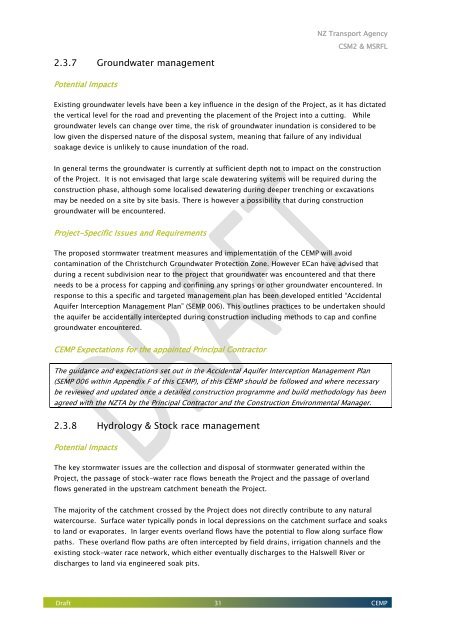CEMP - NZ Transport Agency
CEMP - NZ Transport Agency
CEMP - NZ Transport Agency
Create successful ePaper yourself
Turn your PDF publications into a flip-book with our unique Google optimized e-Paper software.
<strong>NZ</strong> <strong>Transport</strong> <strong>Agency</strong><br />
CSM2 & MSRFL<br />
2.3.7 Groundwater management<br />
Potential Impacts<br />
Existing groundwater levels have been a key influence in the design of the Project, as it has dictated<br />
the vertical level for the road and preventing the placement of the Project into a cutting. While<br />
groundwater levels can change over time, the risk of groundwater inundation is considered to be<br />
low given the dispersed nature of the disposal system, meaning that failure of any individual<br />
soakage device is unlikely to cause inundation of the road.<br />
In general terms the groundwater is currently at sufficient depth not to impact on the construction<br />
of the Project. It is not envisaged that large scale dewatering systems will be required during the<br />
construction phase, although some localised dewatering during deeper trenching or excavations<br />
may be needed on a site by site basis. There is however a possibility that during construction<br />
groundwater will be encountered.<br />
Project-Specific Issues and Requirements<br />
The proposed stormwater treatment measures and implementation of the <strong>CEMP</strong> will avoid<br />
contamination of the Christchurch Groundwater Protection Zone. However ECan have advised that<br />
during a recent subdivision near to the project that groundwater was encountered and that there<br />
needs to be a process for capping and confining any springs or other groundwater encountered. In<br />
response to this a specific and targeted management plan has been developed entitled “Accidental<br />
Aquifer Interception Management Plan” (SEMP 006). This outlines practices to be undertaken should<br />
the aquifer be accidentally intercepted during construction including methods to cap and confine<br />
groundwater encountered.<br />
<strong>CEMP</strong> Expectations for the appointed Principal Contractor<br />
The guidance and expectations set out in the Accidental Aquifer Interception Management Plan<br />
(SEMP 006 within Appendix F of this <strong>CEMP</strong>), of this <strong>CEMP</strong> should be followed and where necessary<br />
be reviewed and updated once a detailed construction programme and build methodology has been<br />
agreed with the <strong>NZ</strong>TA by the Principal Contractor and the Construction Environmental Manager.<br />
2.3.8 Hydrology & Stock race management<br />
Potential Impacts<br />
The key stormwater issues are the collection and disposal of stormwater generated within the<br />
Project, the passage of stock-water race flows beneath the Project and the passage of overland<br />
flows generated in the upstream catchment beneath the Project.<br />
The majority of the catchment crossed by the Project does not directly contribute to any natural<br />
watercourse. Surface water typically ponds in local depressions on the catchment surface and soaks<br />
to land or evaporates. In larger events overland flows have the potential to flow along surface flow<br />
paths. These overland flow paths are often intercepted by field drains, irrigation channels and the<br />
existing stock-water race network, which either eventually discharges to the Halswell River or<br />
discharges to land via engineered soak pits.<br />
Draft 31 <strong>CEMP</strong>
















